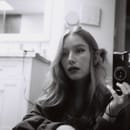A couple of weeks ago one of my friends sent me an Instagram page she thought I’d like to check out. When I saw the name of the page, @the.vulva.gallery, I was immediately intrigued. Upon clicking the username, I was met with hundreds of gorgeous paintings of all different types of vulvas: different shapes, different sizes, different colours. Along with the paintings are stories submitted by various vagina-owning people, telling their stories of struggles with vaginal health, the look of their vulvas, sexual assault and much more. It got me thinking: what have I learned about genital appearance as well as overall genital health, as someone who has a vagina? Honestly, next to nothing. So many women I know have thought that their vulvas look weird, or that they’re not “normal”––but what is “normal”?
The Vulva Gallery has amassed over 500,000 followers since the creation of the page in 2016. Hilde has painted vulvas with vitiligo, bumps, piercings, pubic hair, skin tags, and anything else you can imagine. Inspired, I reached out to Hilde Atalanta, the creator of The Vulva Gallery, about the creation of their page and to get some more insight about the importance of vulva diversity and awareness.
What inspired you to start this page?
Hilde: A few years ago I attended a lecture at the University of Amsterdam (where I studied clinical psychology at that time) and learned about the huge global rise in labiaplasty. I wondered what caused this rise in labiaplasty surgeries and started to do some research on the subject. I noticed that representations of vulvas in the mainstream media often lack in diversity, and that there aren’t many people who speak openly about genital diversity (or specifically: their vulva). It also occurred to me that during sexual health classes as a kid and teenager I had never learned about genital diversity; [class] merely focused on biology and safe sex (or more accurately: how to not get pregnant and how to avoid STDs). I realised that visibility of diversity might actually be helpful to more people: showing a wide range of representations of vulvas, thereby opening up conversation and showing that diversity is good and important.

What impact did you hope to have/what message did you want to spread in starting this page?
Hilde: We’ve somehow gotten the idea that there’s something wrong with us, but there isn’t. To show this, I started The Vulva Gallery in 2016. The Vulva Gallery is an online gallery and educational platform celebrating vulva diversity, aiming to improve sexual health education and opening up conversation about topics that are still being stigmatised. Since 2016, together with a rapidly growing community of over 500,000 followers, I’ve been working on improving this stigmatised image of the vulva.
Why do you think it’s important to normalize vulvas in all shapes and forms?
Hilde: The vulva has been hidden and shamed for many years throughout our western history. Besides that, sexual health education is poor in many countries, and body diversity (representation of physical / genital variations) isn’t part of the lessons taught in schools. Young individuals aren’t taught that their genitals can look very diverse, and that this is OK and normal. When you don’t learn to talk about your body, and when nudity is being shamed and sexualised instead of being normalised, this leads to shame, hiding and a lack of knowledge (and not being able to name or recognise our body parts, and especially our genitalia).
Teaching children and young individuals about body diversity should be a basic principle of sexual health education. From a young age––even before the onset of puberty––children need to learn that their body is perfectly normal as it is, as there exists such a broad range of ‘normal’. We need to encourage children to understand and embrace this diversity, by creating an acceptance of different kinds of body types instead of a rejection or fetishisation of them. I think this could play a big part in solving the problem of low self-esteem; not only will it give young individuals knowledge and confidence about the way they look, but it will also teach them to respect others with different body types by understanding that we all look different, and yet we’re all equal. Sexual health education should be provided throughout children’s schooling; it should be a recurring element of their education, adjusted appropriately to their personal needs at different ages. We must teach kids about body diversity, mutual consent, safe and pleasurable sex, and open and respectful communication. And, accompany this information with images illustrating body diversity. We can give the next generation the tools they need to develop a body-positive and respectful mindset, and we can help them become more confident and more resilient in the face of the influences of the mainstream media and their peers.
Hilde’s message is one of the most important that we can spread to women and anyone else with a vulva, especially young girls who are growing into their bodies. As women, we are merely taught about our bodies in relation to men and their bodies, and how they interact together. Hilde’s paintings portray the fact that all vulvas are beautiful, and there is no “normal”––embrace your body and the beautiful way it looks, empowers you and protects you. Show your body some love back.



